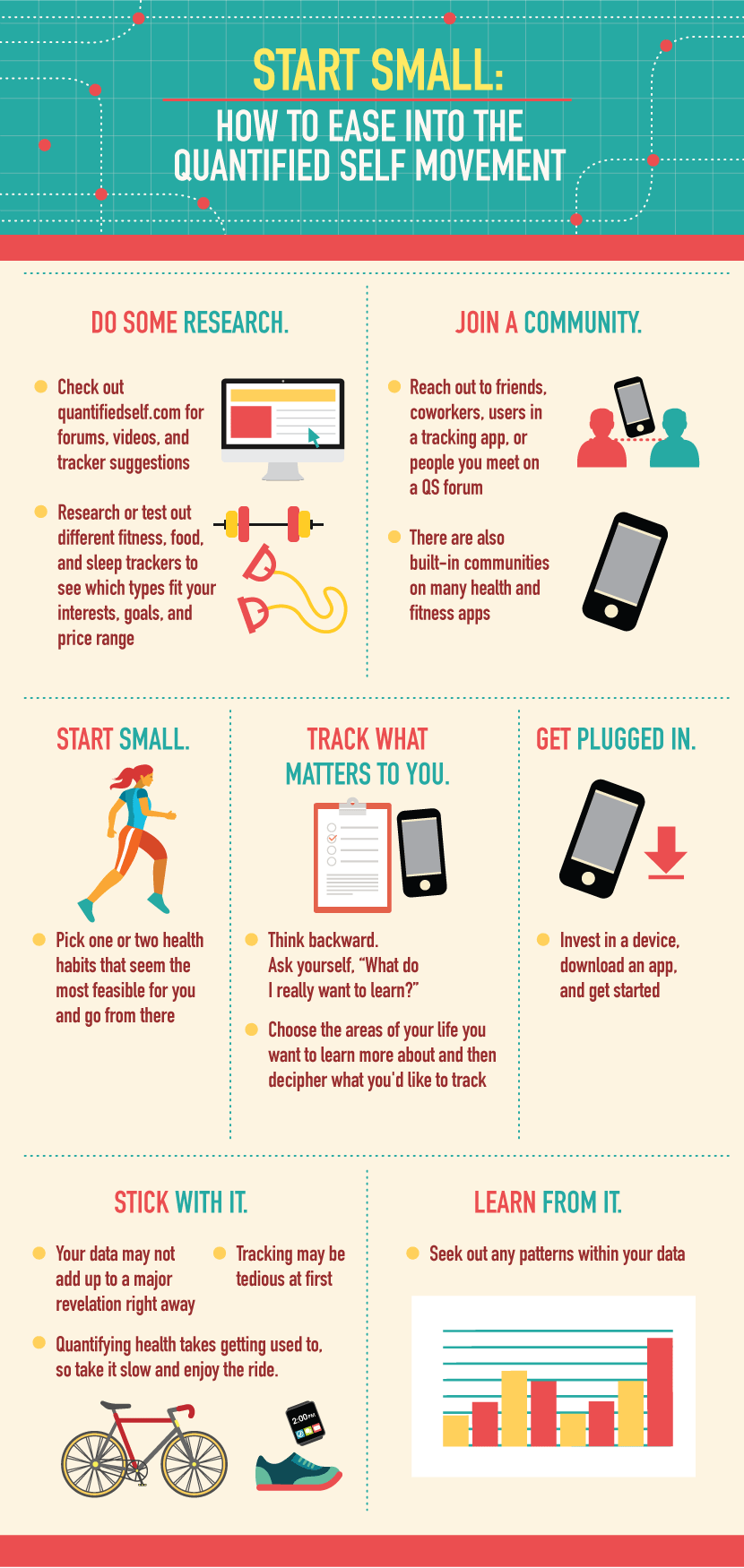Quantify Your Health with the Quantified Self Movement
Want to know yourself better, so you can make healthier choices and feel better? That’s essentially what the Quantified Self movement is all about.
Quantified Selfers (QSs) use various self-tracking methods to measure different facets of their life, which helps indicate specific habits that make them feel a certain way.
They’ll track anything from sleep to food, exercise, heart rate, mood, sex frequency, and bathroom observations.
The goal is to better understand behaviors, which can hopefully lead to certain personal changes and in turn better health.
While the QS movement has increased in recent years, it’s not all that new, nor is it completely out of the ordinary. Millions of people track things every day: Some of us weigh ourselves at the gym, count calories, and log our sleep.
In fact, about 69 percent of Americans track at least one health metric, including weight, sleep, or food intake.http://www.pewinternet.org/2013/01/28/tracking-for-health/
people use apps such as MyFitnessPal to log food and exercise, FitBit to track steps, and Sleep to track (you guessed it) sleep.
The biggest differentiator between simply tracking health and being a part of the “movement” comes down to data. Instead of just jotting down information (for instance, “I consumed 1,900 calories today and spent $52.72 on groceries”),
QSs analyze and learn from their data. They enhance these numbers with technology, which aggregates the data and provides insight on behaviors, trends, and patterns.
Read on to hear how the movement was born and how you can quantify your health.

The beginning of the movement is often associated with Gary Wolf, a contributing editor at Wired Magazine who launched the Quantified Self website in 2008.https://www.ted.com/speakers/gary_wolf
Yet others argue the act of using technology to quantify self-tracking has roots as far back as the 1970s.http://medialab.hva.nl/wp-content/uploads/2013/11/ICERIE2013_Paper_M_Riphagen_AUAS.pdf
Whichever way you look at it, 2008 marks when the movement really took off – when self-knowledge through self-tracking was deemed “Quantified Self” and people began connecting over detailed data collection to lead healthier lives.
Today, more than 50,000 members include data driven people, developers, and the average Joe or Jane. They organize and attend 206 Quantified Self meetups around the globe.http://quantified-self.meetup.com/
An annual QS conference – the most recent one took place this past June in San Francisco – hosts various lectures, office hours, and meet-and-greets.http://qs15.quantifiedself.com/
A 2015 talk discussed quantifying with kids, which shows the intriguing potential for the movement to spread across various generations.
According to Wolf, the point of QS is to act more effectively in the world by knowing ourselves better.http://www.ted.com/talks/gary_wolf_the_quantified_self At the intersection of biology and technology,
people can look to accelerometers found in wearable gadgets and their corresponding apps to calculate, record, and aggregate data.

Interested in getting started with QS? Follow these tips to ease your way into tracking health tracking.
Do some research
There are great resources available to learn more about the QS movement. For starters, there’s the official QS site full of videos and forums. Research or test out different fitness, food,
and sleep trackers to see which types fit your interests, goals, and price range.
Join a community
No movement is complete without a supportive community. Whether it’s your friends, co-workers, users in a tracking app, or people you meet on a QS forum, don’t be shy – reach out and utilize the buddy system.https://forum.quantifiedself.com/forum-qs-newcomers
There are also built-in communities on apps such as MyFitnessPal or RunKeeper.
Start small
There’s no need to go all in and track every step, wink of sleep, gobbled crumb, and mood swing. Pick one or two health habits that seem the most feasible for you and go from there.
Track what matters to you
Additionally, think backward. Don’t start with what you want to track. Instead, ask yourself, “What do I really want to learn?” Choose the areas of your life you’re interested in gleaning insight and then decipher what you’d like to track.
For example, if you want to feel less stressed, consider tracking your sleep to see if there is a pattern between the hours of snooze time you clock each night and how you feel the next day.
Get plugged in
Now it’s time to dial in. Research the fitness and health trackers that suit your style, and learn how to use one. Get started with our nifty guide that breaks down some of the most popular and useful QS tech tools.

Stick with it
Understand that the numbers may not add up to a major revelation right away and that tracking may be a tedious pain. Quantifying health takes getting used to, so take it slow and enjoy the ride.
Learn from it
Crunching numbers is one thing, but breaking them down is a whole new ball game. After you get the hang of it and really figure out what you want to track and measure,
seek out any patterns within your data. For example, insights such as “I tend to feel tired after eating dairy,” or “On days I work out I sleep eight hours rather than six” can be exciting and help you live a healthier, productive, more intuitive life.
Embed the article on your site

